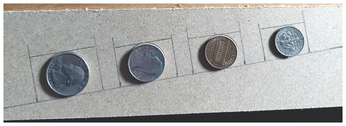Build a coin counter from particleboard and a Pi Pico
Feed the Meter

© Lead Image © Andrey Burmakin, 123RF.com
Parking meters and vending machines detect and count the coins you insert, but how do they work? We'll show you how to mimic the functionality with some particleboard, a Raspberry Pi Pico, a few extra chips, and some Python code.
Counting coins is a problem that was solved decades ago, but I was wondering whether I could come up with a solution of my own. While I may not have the same set of sophisticated tools that a parking meter manufacturer has, it should certainly be possible to create an electronic coin counter using just a Raspberry Pi Pico and some common components. Writing software that can count is trivial, but how do you detect what type of coin was inserted? If you assume that only legal US coins will be used, the easiest way to recognize them is by measuring their diameter. Table 1 lists the diameters of US coins, both in millimeters and in inches [1].
I decided to sort the coins using different sized slots. The coins roll down a small ramp and pass several cut-out slots. If the coin is the correct size, it falls through the slot. The required width of the slot depends on how fast the coin is rolling past whereas the height of the slot needs to be slightly larger than the actual coin while still being smaller than the next largest coin. In my case, the slots were approximately twice the width of the coin (see Figure 1).
 Figure 1: Each coin slot needs the right height and width so that coins will fall through the correct slots.
Figure 1: Each coin slot needs the right height and width so that coins will fall through the correct slots.
[...]
Buy this article as PDF
(incl. VAT)
Buy Linux Magazine
Subscribe to our Linux Newsletters
Find Linux and Open Source Jobs
Subscribe to our ADMIN Newsletters
Support Our Work
Linux Magazine content is made possible with support from readers like you. Please consider contributing when you’ve found an article to be beneficial.

News
-
Debian Unleashes Debian Libre Live
Debian Libre Live keeps your machine free of proprietary software.
-
Valve Announces Pending Release of Steam Machine
Shout it to the heavens: Steam Machine, powered by Linux, is set to arrive in 2026.
-
Happy Birthday, ADMIN Magazine!
ADMIN is celebrating its 15th anniversary with issue #90.
-
Another Linux Malware Discovered
Russian hackers use Hyper-V to hide malware within Linux virtual machines.
-
TUXEDO Computers Announces a New InfinityBook
TUXEDO Computers is at it again with a new InfinityBook that will meet your professional and gaming needs.
-
SUSE Dives into the Agentic AI Pool
SUSE becomes the first open source company to adopt agentic AI with SUSE Enterprise Linux 16.
-
Linux Now Runs Most Windows Games
The latest data shows that nearly 90 percent of Windows games can be played on Linux.
-
Fedora 43 Has Finally Landed
The Fedora Linux developers have announced their latest release, Fedora 43.
-
KDE Unleashes Plasma 6.5
The Plasma 6.5 desktop environment is now available with new features, improvements, and the usual bug fixes.
-
Xubuntu Site Possibly Hacked
It appears that the Xubuntu site was hacked and briefly served up a malicious ZIP file from its download page.

